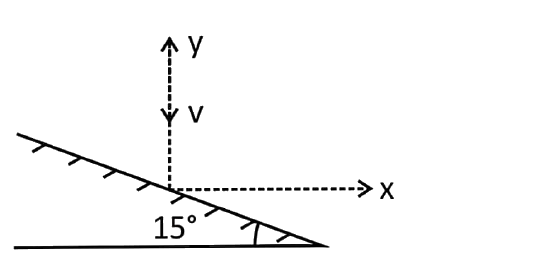An object is moving on a plane surface with uniform velocity 10ms−1 in presence of a force 10N. The frictional force between the object and the surface is
1N
−10N
10N
100N
The correct Answer is:B
To solve the problem, we need to analyze the forces acting on the object moving on a plane surface with a uniform velocity of 10m/s in the presence of a force of 10N.
1. Understand the Situation: The object is moving with a uniform velocity, which means that its speed is constant. According to Newton's first law of motion, if an object is moving with a constant velocity, the net force acting on it must be zero.
2. Identify the Forces: There are two main forces acting on the object:
- The applied force (Fapplied) of 10N in the direction of motion.
- The frictional force (Ffriction) acting in the opposite direction of motion.
3. Set Up the Equation for Net Force: Since the object is moving with a uniform velocity, the net force acting on it is zero. Therefore, we can write the equation:
Fapplied−Ffriction=0
4. Substitute the Known Values: We know that the applied force is 10N. Substituting this into the equation gives:
10N−Ffriction=0
5. Solve for the Frictional Force: Rearranging the equation to solve for the frictional force gives:
Ffriction=10N
6. Direction of the Frictional Force: The frictional force acts in the opposite direction to the applied force, but its magnitude is 10N.
Final Answer:
The frictional force between the object and the surface is 10N.
---
- The applied force (Fapplied) of 10N in the direction of motion.
- The frictional force (Ffriction) acting in the opposite direction of motion.
Fapplied−Ffriction=0
10N−Ffriction=0
Ffriction=10N
The frictional force between the object and the surface is 10N.
Similar Questions
An object of mass 1 kg moving on a horizontal surface with initial velocity 8 m/s comes to rest after 10 s. If one wants to keep the object moving on the same surface with velocity 8 m/s the force required is
View SolutionAn object is moving towards a mirror with a velocity of 10ms−1 as shown in the figure. If the collision between the mirror and the object is perfectly elastic, then the velocity of the image after collision with mirror in vector form is
 View Solution
View Solution
Knowledge Check
- Question 1 - Select One
The frictional force between two surfaces is independent of
ANature of surfaceBSize of the bodyCArea of contactDMass of the body - Question 2 - Select One
An object of mass 6 kg is sliding on a frictionless horizontal surface with a uniform speed of 3 ms. The force required to keep the object moving at the same speed along the same straight line is
A27 newtonsB54 newtonsCZero newtonD18 newtons - Question 3 - Select One
When a body is moving on a surface, the force of friction is called
AStatic friction.BDynamic friction.CLimiting friction.DRolling friction.
Analysis Of Friction Force Between Two Objects In Contact
View SolutionWhen a body is moving on a surface, the force of friction is called
View SolutionA block moving on a horizontal surface with velocity 20ms−1 comes to rest because of surface friction over a distance of 40 m. Taking g=10ms−2 , the coefficient of dynamic friction is :
View SolutionAn object of mass 20 kg is moving with a uniform velocity of 8ms−1 . The kinetic energy possessed by the object is :
View SolutionAn object moving with a uniform velocity of 4ms-possesses kinetic energy of 120 J. Find the mass of the object.
View Solution

